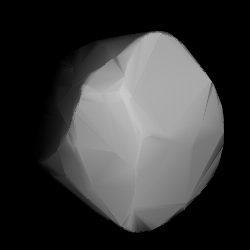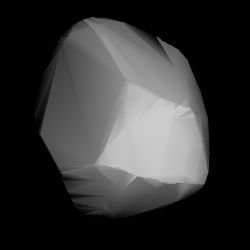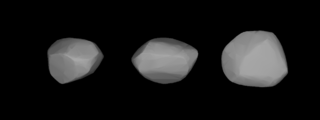
Proserpina is a main-belt asteroid discovered by German astronomer R. Luther on May 5, 1853. It is named after the Roman goddess Proserpina, the daughter of Ceres and the Queen of the Underworld. Another main-belt asteroid, 399 Persephone, discovered in 1895, is named after her Greek counterpart.

137 Meliboea is a large, dark main-belt asteroid that was discovered by Austrian astronomer J. Palisa at the Austrian Naval Observatory on 21 April 1874, the second of his many asteroid discoveries. It was later named after Meliboea, the daughter of Oceanus and Tethys in Greek mythology. The largest body in the Meliboea family of asteroids that share similar orbital elements, only 791 Ani approaches its size. It is classified as a C-type asteroid and may be composed of carbonaceous materials. The spectra of the asteroid displays evidence of aqueous alteration.

Bertha is a main-belt asteroid. It was discovered by the French brothers Paul Henry and Prosper Henry on 4 November 1875, but the credit for the discovery was given to Prosper. It is probably named after Berthe Martin-Flammarion, sister of the astronomer Camille Flammarion.

Eudora is a large Main belt asteroid. It was discovered by French (Corsican) astronomer J. Coggia on August 30, 1880, in Marseilles, France. It was his fourth asteroid discovery and is named after Eudora, a Hyad in Greek mythology.

225 Henrietta is a very large outer main-belt asteroid. It was discovered by Austrian astronomer Johann Palisa on April 19, 1882, in Vienna and named after Henrietta, wife of astronomer Pierre J. C. Janssen. The asteroid is orbiting at a distance of 3.39 AU from the Sun with a period of 6.24 years and an eccentricity (ovalness) of 0.26. The orbital plane is inclined at an angle of 20.9° to the plane of the ecliptic. 225 Henrietta belongs to Cybele group of asteroids and is probably in a 4:7 orbital resonance with the planet Jupiter.

Vindobona is a large Main belt asteroid. It was discovered by Austrian astronomer Johann Palisa on September 10, 1882. Vindobona is the Latin name for Vienna, Austria, the city where the discovery was made.
Russia is a large Main belt asteroid. It is classified as a C-type asteroid and is probably composed of primitive carbonaceous material. It was discovered by Johann Palisa on 31 January 1883 in Vienna, who named it after the country of Russia.

Kriemhild is a main belt asteroid that was discovered by Austrian astronomer Johann Palisa on 22 September 1884 in Vienna and was named after Kriemhild, a mythological Germanic princess, by Moriz von Kuffner, a Viennese industrialist and sponsor of astronomy.

Alice is a stony background asteroid from the inner region of the asteroid belt. It was discovered by Johann Palisa on 25 April 1890 at the Vienna Observatory.

Eduarda is a main belt asteroid that was discovered by German astronomer Max Wolf on 25 September 1892 in Heidelberg. It was named after German banker and amateur astronomer Heinrich Eduard von Lade.

Myrrha is a main-belt asteroid that was discovered by the French astronomer Auguste Charlois on January 10, 1894, in Nice. It has been classified as a C-type asteroid and is most likely composed of carbonaceous material.
Merapi is a main belt asteroid orbiting the Sun. It was discovered by American astronomer George Henry Peters on May 11, 1904, from Washington, D.C.
Friederike is a minor planet orbiting in the asteroid belt. It is a member of the Hygiea family of asteroids.
618 Elfriede is a minor planet orbiting the Sun. On July 24, 2013, it occulted the magnitude 12.8 star 2UCAC 23949304, over parts of Mexico and southwestern United States.
630 Euphemia is a mid-sized Eunomian asteroid.

665 Sabine is a minor planet orbiting the Sun that was discovered by German astronomer Wilhelm Lorenz on July 22, 1908.

708 Raphaela is a minor planet orbiting the Sun.
799 Gudula is a minor planet orbiting the Sun discovered by German astronomer Karl Wilhelm Reinmuth on 9 March 1915 at the Heidelberg observatory.
4175 Billbaum, provisional designation 1985 GX, is a background asteroid from the central regions of the asteroid belt, approximately 9 kilometers in diameter. It was discovered on 15 April 1985, by American astronomer Edward Bowell at the Anderson Mesa Station of the Lowell Observatory near Flagstaff, Arizona. The uncommon L-type asteroid has a short rotation period of 2.73 hours and was named for American astronomer William A. Baum.

1334 Lundmarka, provisional designation 1934 OB, is a carbonaceous asteroid from the outer region of the asteroid belt, approximately 30 kilometers in diameter. It was discovered on 16 July 1934, by German astronomer Karl Reinmuth at Heidelberg Observatory in southern Germany, and named after Swedish astronomer Knut Lundmark.













